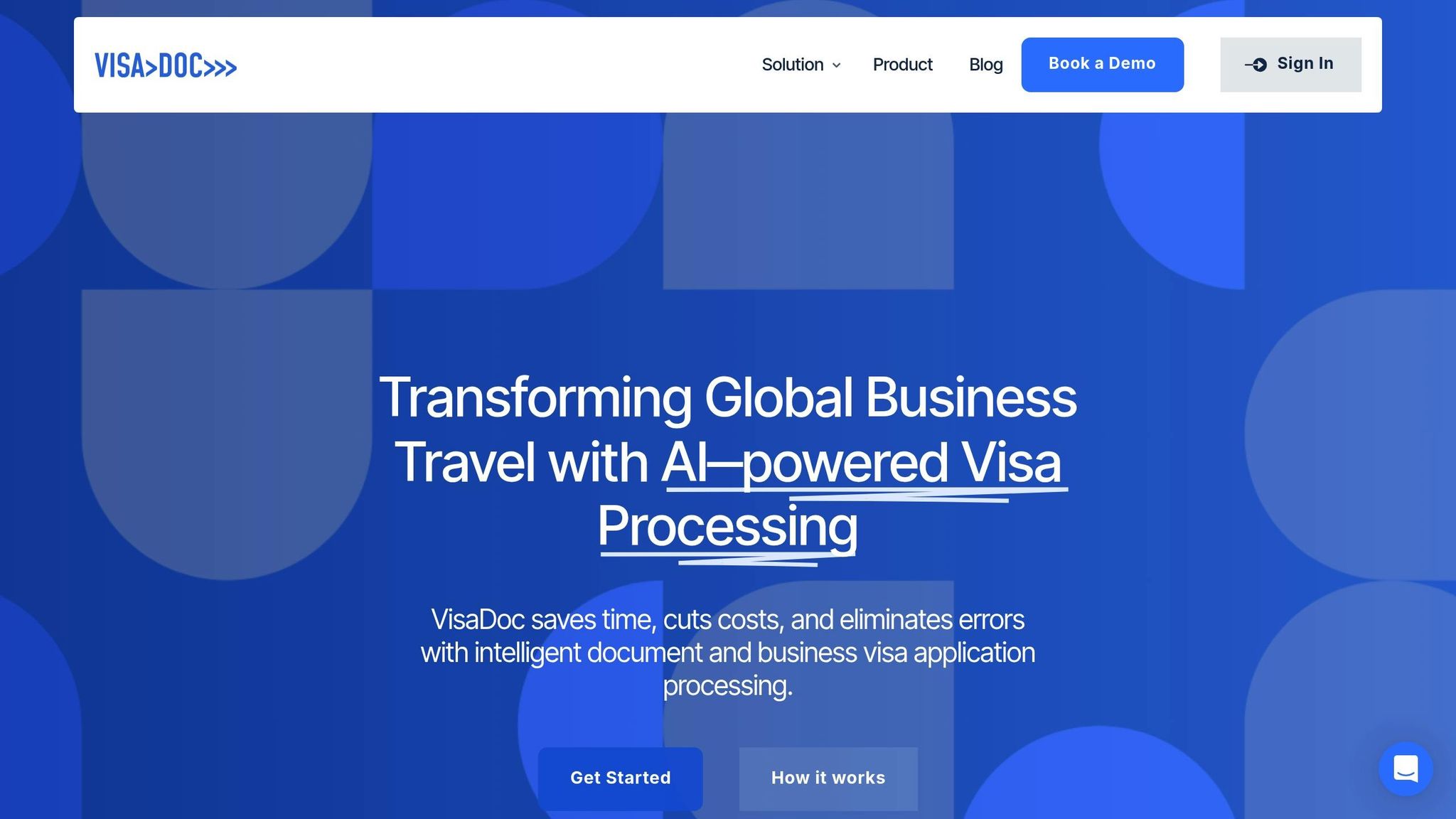Managing visas manually is expensive and time-consuming. Automation can save costs, reduce errors, and improve compliance. Here's how automated visa management systems deliver value:
- Save Time: Automation reduces administrative hours by handling repetitive tasks like data entry and document verification.
- Cut Costs: Avoid fines and legal fees caused by compliance errors or missed deadlines.
- Boost Accuracy: Built-in checks minimise mistakes and ensure up-to-date compliance with visa regulations.
- Support Growth: Scalable systems handle increased visa volumes without extra overhead.
- Proactive Compliance: Automated tools track regulatory changes and visa expirations, preventing costly risks.
For businesses managing international workforces, platforms like VisaDoc offer tools for faster processing, compliance tracking, and global coverage. These systems simplify operations and deliver a measurable return on investment.
Manual Visa Processing Expenses
Handling visa applications manually can be costly for organisations, both in terms of time and money. These challenges often hinder productivity and overall performance. Let’s break down the main expenses tied to manual visa processing.
Staff Time and Administrative Work
Manual visa processing requires significant effort from HR teams. They spend hours managing paperwork, coordinating documents, and navigating administrative tasks. This not only consumes valuable time but also pulls HR professionals away from focusing on more strategic, business-critical initiatives.
Mistakes and Compliance Penalties
Errors are almost unavoidable in manual visa processing. Mistakes like submitting incorrect information or missing deadlines can lead to compliance issues. These errors often result in fines and legal fees, adding a financial strain to an already time-consuming process.
Delays and Process Inefficiencies
Manual methods are prone to bottlenecks, which can delay visa approvals. These hold-ups make it harder to quickly onboard international talent, pushing back project timelines and increasing operational costs. Such inefficiencies can significantly impact an organisation’s ability to remain agile and competitive.
ROI Factors in Visa Automation
Tackling the high costs and inefficiencies of manual visa processing opens the door to significant returns. Implementing automated visa management systems simplifies key processes and trims operational expenses, delivering measurable benefits.
Reduced Processing Hours
Automation takes over repetitive tasks like data entry, document verification, and status updates. By doing so, organisations can free up their staff for more strategic, value-driven activities, dramatically cutting down the time spent on routine processing.
Improved Accuracy
Automated systems bring consistency and precision through standardised workflows and built-in validation checks. This reduces the risk of common manual errors, ensures compliance with changing visa regulations, and maintains accurate audit trails. These features not only save time but also help avoid costly rework or penalties tied to regulatory missteps.
Scaling for Growth
For organisations expanding internationally, automation can handle a growing number of visa applications without adding extra overhead. This scalability ensures smooth processing, supports operational growth, and makes the best use of available resources.
Risk Management Results
Automating visa management streamlines compliance tracking and reduces regulatory risks, protecting organisations from costly penalties.
Regulation Tracking
Modern visa management platforms are designed to monitor regulatory changes across different regions. They automatically flag updates to visa requirements, ensuring businesses stay compliant without the need for constant manual checks. With automated regulation tracking, organisations can:
- Receive instant alerts about changes in visa policies
- Access updated documentation requirements with ease
- Track jurisdiction-specific rules as they evolve
- Maintain compliance records that are audit-ready at all times
In addition to staying on top of regulation changes, actively managing visa expiries is another crucial step in reducing risk.
Expiry Management
Keeping track of visa expiration dates is essential for avoiding compliance issues. Automated systems handle this by monitoring visa validity and initiating renewal processes well before deadlines. This proactive approach offers several benefits:
- Early notifications to warn of upcoming expirations
- Structured workflows that ensure timely renewals
- Real-time tracking of all active visas and their expiry dates
By addressing expirations in advance, businesses minimise the risk of disruptions and avoid unnecessary costs.
Cost Prevention
When regulation tracking and expiry management work together, they provide strong financial protection for organisations. Automation helps avoid compliance breaches, preventing fines and operational setbacks. By staying compliant, companies save money and reduce the likelihood of legal complications.
VisaDoc’s integrated platform is a prime example of how automation can revolutionise risk management. With tools for tracking regulatory updates, managing visa expirations, and ensuring compliance, it not only minimises penalties but also boosts operational efficiency, delivering a clear return on investment.
VisaDoc System Benefits

Core Platform Features
VisaDoc's AI-powered platform simplifies visa processing, helping organisations save time and increase efficiency. By offering a centralised repository of visa guides and data, HR teams can instantly access up-to-date requirements, ensuring smoother operations.
Key automation features include:
- AI-driven document verification to minimise errors
- Automated application processing with compliance checks
- Real-time tracking of visa requirements
- Seamless integration with HR and travel management systems
The platform also offers a flexible pricing structure, making it adaptable to businesses of various sizes.
Cost Structure
VisaDoc uses a tiered pricing model, designed to suit organisations of different scales and needs:
| Plan Type | Features | Best Suited For |
|---|---|---|
| Free Plan | • Access to visa guides • Centralised information • Self-service tools |
Small businesses starting with visa management automation |
| Assisted Options | • Custom notifications • Expert-curated content • Compliance support • Advanced automation |
Medium to large enterprises managing complex visa needs |
The Assisted Options plan is ideal for organisations handling multiple visa applications, ensuring compliance and enhanced automation. This pricing model is scalable, aligning with VisaDoc's international capabilities.
Global Coverage
For businesses operating internationally, VisaDoc's global reach is a game-changer. The system stays updated with visa requirements across different jurisdictions, enabling organisations to:
- Generate location-specific documentation
- Monitor regional compliance standards
- Stay informed about policy changes
- Streamline cross-border operations
With API integrations and automated workflows, VisaDoc simplifies visa management for any destination or visa type, making it a valuable tool for global operations.
Conclusion
Automated visa management systems offer a clear return on investment by cutting costs, improving efficiency, and ensuring compliance. By streamlining processes, organisations can save time and resources while keeping up with legal requirements.
Automation provides both immediate and lasting advantages. It reduces the need for manual processing, simplifies compliance tracking, and easily adapts to the demands of a growing organisation. These benefits lead to tangible savings and operational improvements, including:
- Shorter processing times and less administrative workload
- Better compliance tracking to minimise risks
- Smooth handling of larger visa volumes as needs grow
To get the most out of automation, businesses should evaluate their current costs, start with high-volume visa types, provide thorough staff training, and regularly monitor system performance. These steps pave the way for maximising the potential benefits of automation.
The boost in efficiency, accuracy, and compliance translates to long-term savings and smoother operations. For organisations looking to modernise their visa management, platforms like VisaDoc stand out, offering advanced compliance tools, global reach, and flexible pricing to meet diverse needs.
FAQs
How does an automated visa management system like VisaDoc help businesses stay compliant with changing visa regulations?
VisaDoc takes the hassle out of staying compliant by keeping a close watch on changes to visa regulations and ensuring every application meets the latest standards. This forward-thinking approach helps minimise the chances of mistakes, legal troubles, or penalties.
With automation at its core, VisaDoc streamlines crucial steps in the process, helping HR and legal teams handle visa applications with ease. It not only saves time but also ensures everything is done according to current regulations.
What are the key cost-saving advantages of using automated visa management systems?
Switching to an automated visa management system like VisaDoc can help businesses cut costs in several ways. By automating the process, companies can save administrative hours, reduce mistakes, and steer clear of expensive penalties tied to visa regulation breaches.
On top of that, automation simplifies workflows, keeping HR and legal teams aligned with ever-changing visa requirements. This not only boosts efficiency but also makes it easier for employees to move across borders, ultimately saving both time and resources.
How can businesses evaluate the ROI of an automated visa management system?
Businesses can measure the return on investment (ROI) of automated visa management systems by examining key advantages like saving both time and money. By automating the visa process, companies can dramatically cut down processing times, freeing up HR and legal teams to concentrate on more strategic tasks. At the same time, automation helps to lower administrative expenses.
Another major benefit is the reduction in application errors. Fewer mistakes mean less chance of delays, denied entries, or fines due to compliance issues. On top of that, smoother processes and better compliance contribute to seamless employee mobility, which can positively influence overall business performance and revenue.













